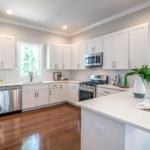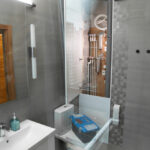INTERIOR
Bathroom and Kitchen Remodeling

At ROJO Home Improvement, our bathroom and kitchen remodeling services are about more than just aesthetics; they’re about creating functional, inviting spaces tailored to your lifestyle. Our certified team focuses on intelligent design solutions, from space-saving cabinetry to energy-efficient fixtures, ensuring each remodel meets your specific needs and preferences.
Commonly Asked Questions
The timeline for a bathroom or kitchen remodel can vary quite a bit depending on the scope of the project, but here is a general overview of a typical timeline:
Planning and Design Phase:
– 1-4 weeks to select finishes, fixtures, layout, etc. and get plans finalized
Permitting:
– 1-4 weeks to obtain any necessary permits from the local building department
Demolition:
– 1-3 days to remove existing cabinetry, fixtures, flooring, etc.
Rough-In Work:
– 1-3 weeks for plumbing, electrical, and HVAC work
– This may involve relocating or adding new plumbing lines, electrical circuits, and HVAC vents
Installation:
– 2-4 weeks to install new cabinetry, countertops, tile, fixtures, etc.
– This is the longest phase of the project
Finishing Touches:
– 1-2 weeks for painting, trim work, cleanup, and final inspections
Total Timeline:
– For a typical mid-size bathroom remodel, the total timeline is usually 4-8 weeks
– For a mid-size kitchen remodel, the total timeline is usually 6-12 weeks
These timelines can vary quite a bit based on the complexity of the project, availability of materials/labor, and any unexpected issues that arise during construction. But this should give you a general sense of what to expect for a standard bathroom or kitchen remodel.
In many cases, it is possible to stay in your home during a bathroom or kitchen remodel, but it depends on the scope and complexity of the project. Here are some key considerations:
Staying during a Bathroom Remodel:
– For a basic bathroom remodel, it is often feasible to remain in the home, as long as you have access to another functioning bathroom.
– However, if the project involves major plumbing or electrical work that disrupts water/power, you may need to temporarily relocate.
– The noise, dust, and limited access to the bathroom under construction can be inconvenient for residents.
Staying during a Kitchen Remodel:
– Staying in the home during a kitchen remodel is more challenging, as the kitchen is a central hub of the house.
– You’ll likely be without a functioning kitchen for 4-8 weeks, so you’ll need to plan for temporary meal preparation, such as using a microwave, outdoor grill, or setting up a temporary kitchen in another room.
– The construction noise, dust, and limited access to the kitchen can make living at home very disruptive.
Other Considerations:
– If the project requires the home to be vacant for certain phases, such as asbestos abatement or major structural work, you may need to relocate temporarily.
– Staying onsite can also be more difficult if you have young children or pets that need to be out of the construction zone.
Overall, while staying in the home during a remodel is possible in many cases, it requires careful planning and flexibility.
Choosing the right fixtures and finishes for a bathroom or kitchen remodel can be a bit of a process, but here are some tips to help guide you:
1. Define your style and budget:
– Decide on the overall aesthetic you want – e.g. modern, traditional, farmhouse, etc.
– Determine your budget range for fixtures, appliances, cabinets, countertops, etc.
2. Research and gather inspiration:
– Look through home design magazines, websites, and showrooms to get ideas.
– Create a mood board or Pinterest board to compile your favorite looks.
– Take note of finishes, materials, and brands that appeal to you.
3. Consider functionality and durability:
– Think about how you use the space and what features are most important.
– Choose fixtures and finishes that are well-made and suitable for the high-use areas.
– Consider things like water pressure, energy efficiency, and ease of cleaning.
4. Coordinate the finishes:
– Select a cohesive color palette and finish (e.g. brushed nickel, matte black, etc.).
– Ensure the fixtures, tile, countertops, and other elements complement each other.
5. Get samples and see them in person:
– Order physical samples of finishes like tile, countertop materials, and paint colors.
– See how they look in the actual space and with the existing elements.
6. Consult a designer or showroom staff:
– An interior designer can help pull the whole look together.
– Showroom experts can offer guidance on brands, pricing, and coordinating elements.
The key is to strike a balance between your personal style, functional needs, and cohesive design. Take your time exploring options and don’t be afraid to get creative!

Craftsmanship

Reliability

Integrity





